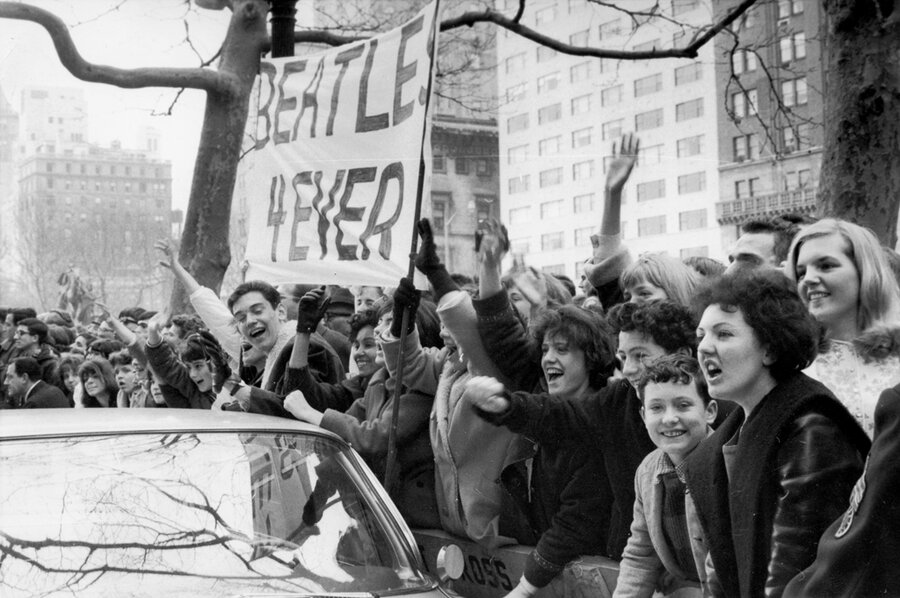I meet the Beatles!
Loading...
"It isn't enough to be a good writer," Clarence Sligar routinely told his third-period journalism class of eighth- and ninth-graders. "A top-notch reporter must also be determined, persistent, and curious."
And daring, I discovered.
It was February 1964. For weeks we'd heard the Beatles were coming to Miami to appear live on "The Ed Sullivan Show," their second appearance in a row. For weeks, the Miami Springs (Fla.) Junior High newspaper staff had been buzzing about how and where to try for an interview.
Exuding confidence and pride, Mr. Sligar went to the principal to ask that his team be allowed to leave school early on Feb. 13, the day the Fab Four would arrive at nearby Miami International Airport. I was selected to land an interview, accompanied by a photographer.
Armed with permission slips from our parents and construction-paper press badges, Kenny and I set out. A classmate's mom had to drop us off.
We were met by throngs of journalists, hapless passengers, and more than 7,000 surging Beatles fans.
Twenty minutes of inspired maneuvers got us through the crowds of Beatles admirers to the end of a carpeted corridor. A frazzled guard at the VIP gate glanced curiously at the badges pinned to our shirts, then unhooked the chain for us to pass.
The scene outside was unnerving. Hundreds of fans dotted the airport roof; scores of others were mashed against the interior concourse glass. Each plane appearing on the horizon set off waves of screams that grew more intense as the band's plane tarried. Patience began to melt in the hot afternoon sun.
Mercifully, a man with a bullhorn announced that National Airlines Flight 11 from New York had landed. To confirm the arrival, Kenny and I navigated crablike through the crowd. Within minutes, the Beatles' jet was less than 50 yards from where we stood.
Ordinary passengers deplaned to the hoots and cheers of the massive welcoming committee. Several unknowns prolonged the agony by pausing at the top of the steps to wave and blow kisses. At last a real mop top appeared, setting the concourse reeling with delirium. The throng lunged forward as the Beatles descended the silver jetway. Police locked arms and shoved back against the crowd.
Girls on the roof screeched and fell to their knees in helpless ecstasy. Behind us the first of about a dozen windows and glass doors shattered from the press of the mob.
Beatlemania had arrived.
Police formed a human barricade as John, Paul, George, and Ringo sprinted across the tarmac to a waiting limousine.
I had only an instant to make a move. I ducked under the cops' outstretched arms and bolted for the idling limo. I glanced back to see Kenny sprawled on the ground, groping for his camera.
The last Beatle pulled his legs into the car and slammed the door. I was too late. Tears of fear and disappointment pricked the back of my eyes.
The police I'd just outrun were only steps away. I grabbed the door handle and knocked desperately on the glass.
Suddenly, the window slid down. Eyeing my press badge, John leaned out and banished my pursuers with a wave of his hand.
The police stepped away, and I pulled out my list of questions. "How do you like America?" I promptly forgot the answer, then stumbled over my next inquiry. John answered patiently; Paul and Ringo jumped in with silly remarks and giggles. It was hard to say who was having the more memorable experience.
Then the limo started to move. I trotted alongside, still clutching the door handle until the limo began to pick up speed and I had to let go. John blew me a kiss. The window slid shut. The interview was over.
Kenny rushed to my side and we hugged, not believing what had just happened. How had a risk-averse, goody-two-shoes like me worked up the gumption to get the story – scooping all the professional press that day?
Only years later did I realize that it was the thought of disappointing beloved Mr. Sligar that had urged me on.
Back on the tarmac, a group of fans surrounded me and asked for my autograph. At 13, I felt I'd hit the big time.
When the limo was no more than a speck on the horizon, fans and reporters wandered away. Turning to take a last look, I whispered, "John, I love you!"
I hope he heard me.





